Michelle Smith, a manager consultant from Atlanta, recently received an exciting invitation to visit her boyfriend’s family in Jamaica. While the prospect of meeting them for the first time filled her with joy, an ever-present fear of traveling was casting a shadow on her plans. The mere thought of ascending into the sky thousands of feet above the ground sent shivers down her spine. This marked Michelle’s ongoing struggle with hodophobia, a fear that had become a significant impediment to her travel dreams and her desire to explore new cultures.
Hodophobia
Hodophobia, categorized as a specific phobia, is characterized by an intense, irrational dread of travel. Individuals grappling with hodophobia experience a surge of distressing symptoms when the idea of a journey surfaces. Such symptoms include racing heartbeats, profuse sweating, and breathlessness, to name a few. This fear can be so paralyzing that it compels individuals to shun travel altogether, depriving them of valuable experiences and personal growth. Luckily, professional guidance and effective strategies, such as therapy or counseling, can empower individuals to confront and conquer their fear of flying.
Deciphering the Origins of Hodophobia
Hodophobia is not one-size-fits-all; its roots vary from person to person. For some, it stems from a past traumatic travel experience. Others grapple with a fear of losing control or navigating unfamiliar terrains. Recognizing the underlying causes is essential in addressing this fear and developing effective coping mechanisms to overcome it.
Recognizing the Signs of Hodophobia
Hodophobia manifests in diverse symptoms, as detailed by the experts at the Perelman School of Medicine at the University of Pennsylvania. These may include panic attacks, an accelerated heart rate, excessive perspiration, trembling, and an overpowering urge to avoid any form of travel. This condition can also lead to excessive pre-trip anxiety. It often compels individuals to go to great lengths to evade situations that trigger their fear. Acknowledging these symptoms is the first step toward breaking free from the chains of hodophobia.
Charting the Course to Recovery
Fortunately, there’s a roadmap to recovery for those dealing with hodophobia. According to the Anxiety and Depression Association of America, treatment options encompass cognitive-behavioral therapy (CBT), exposure therapy, and medication. CBT equips individuals with tools to identify and challenge their irrational thoughts and beliefs about travel. Exposure therapy gradually immerses them in their feared scenarios within a controlled and supportive environment. Medication, such as anti-anxiety medications or selective serotonin reuptake inhibitors (SSRIs), may also be prescribed to manage symptoms.





